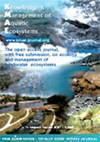揭示潜水交换对温带低地河流底栖大型无脊椎动物组成和丰度的影响
IF 1.7
3区 环境科学与生态学
Q3 FISHERIES
引用次数: 9
摘要
我们研究了Biebrza上游的大型无脊椎动物的分布和丰度与潜水交换(HWE)模式的关系,Biebrza上游是位于波兰东北部的一条小的、低地的、低动态的欧洲河流。在6公里长的河段上;我们通过使用压力梯度的直接现场测量来确定地下水-地表水相互作用,确定了潜流带水交换的变异性。我们确定了具有上升流和下升流通量的位置,以及沿河地下水和地表水之间模糊的水力接触。在这些地点,我们取样了海底栖息的大型无脊椎动物。共鉴定出底栖大型无脊椎动物34个分类群627个个体。研究结果表明,在河流水进入潜流带的河段,底栖大型无脊椎动物的数量和种类更为丰富。研究结果还显示,在已诊断有渗透条件的河段(下潜带的下涌通量)中,底栖大型无脊椎动物的分类丰富度和丰度高于排水河段(下潜带的上涌通量),但差异无统计学意义。本文章由计算机程序翻译,如有差异,请以英文原文为准。
Revealing the influence of hyporheic water exchange on the composition and abundance of bottom-dwelling macroinvertebrates in a temperate lowland river
We studied distributions and abundances of macroinvertebrates in relation to hyporheic water exchange (HWE) patterns of the upper Biebrza − a small, lowland, low dynamic European river located in Northeast Poland. On a 6-km stretch of the river; we determined the variability of water exchange in the hyporheic zone by using direct field measurements of the pressure gradient to determine groundwater–surface water interactions. We identified locations with upwelling and downwelling fluxes of HWE as well as ambiguous hydraulic contact between groundwater and surface water along the river. In these locations, we sampled bottom-dwelling macroinvertebrates. In total, 627 individuals of benthic macroinvertebrates of 34 taxa were identified. We revealed that bottom-dwelling macroinvertebrate fauna is more abundant and diverse in river stretches where water from the river infiltrates the hyporheic zone. Results also show higher taxonomic richness and abundances of benthic macroinvertebrates in stretches with diagnosed infiltrating conditions (downwelling flux in a hyporheic zone) compared to in stretches where the river drained groundwater (upwelling flux in a hyporheic zone), but the recorded differences were not statistically significant.
求助全文
通过发布文献求助,成功后即可免费获取论文全文。
去求助
来源期刊

Knowledge and Management of Aquatic Ecosystems
环境科学-海洋与淡水生物学
CiteScore
3.70
自引率
5.60%
发文量
22
审稿时长
>12 weeks
期刊介绍:
Knowledge and Management of Aquatic Ecosystems (KMAE-Bulletin Français de la Pêche et de la Pisciculture since 1928) serves as a foundation for scientific advice across the broad spectrum of management and conservation issues related to freshwater ecosystems.
The journal publishes articles, short communications, reviews, comments and replies that contribute to a scientific understanding of freshwater ecosystems and the impact of human activities upon these systems. Its scope includes economic, social, and public administration studies, in so far as they are directly concerned with the management of freshwater ecosystems (e.g. European Water Framework Directive, USA Clean Water Act, Canadian Water Quality Guidelines, …) and prove of general interest to freshwater specialists. Papers on insular freshwater ecosystems and on transitional waters are welcome. KMAE is not a preferred journal for taxonomical, physiological, biological, toxicological studies, unless a clear link to ecological aspects can be established. Articles with a very descriptive content can be accepted if they are part of a broader ecological context.
 求助内容:
求助内容: 应助结果提醒方式:
应助结果提醒方式:


